The mourning gecko (Lepidodactylus lugubris) can live up to 15 years, which is amazing for such a small creature. These nocturnal geckos from Southeast Asia are long-lived and can reproduce without males. They are all female, showing nature’s incredible design.
These arboreal geckos are only 3.5″ to 4″ long, including their tails. They are experts at adapting. They are active both day and night and can change their skin color to hide. Their sticky feet let them climb smooth surfaces easily, making them great pets for reptile lovers.
Insect-eating geckos are also social and live in groups. They communicate with chirps, clicks, and whistles. They are easy to care for and have big personalities. Mourning geckos are perfect for beginners who want to learn about lizards.
Parthenogenesis: The Remarkable Reproductive Ability of Mourning Geckos
Mourning geckos, known as Lepidodactylus lugubris, have an amazing way to reproduce. They can make eggs without a male, thanks to parthenogenesis. This means the babies are just like their mom, making them genetic clones.
All-Female Species: No Males Required for Reproduction
These geckos don’t need males to keep their population going. They live in places like tropical forests and cities, thanks to their special way of making babies. This lets them quickly move into new areas, making them common in the Pacific.
Cloning Themselves: Offspring as Genetic Replicas
Parthenogenesis in mourning geckos means two eggs from the same mom can come together to make a baby. So, every baby is just like its mom, genetically speaking. This way, they can keep their species going without needing males.
Mourning geckos show us how amazing nature can be with parthenogenesis and all-female species. Their unique way of making babies helps them survive and spread out, making them very interesting to study.
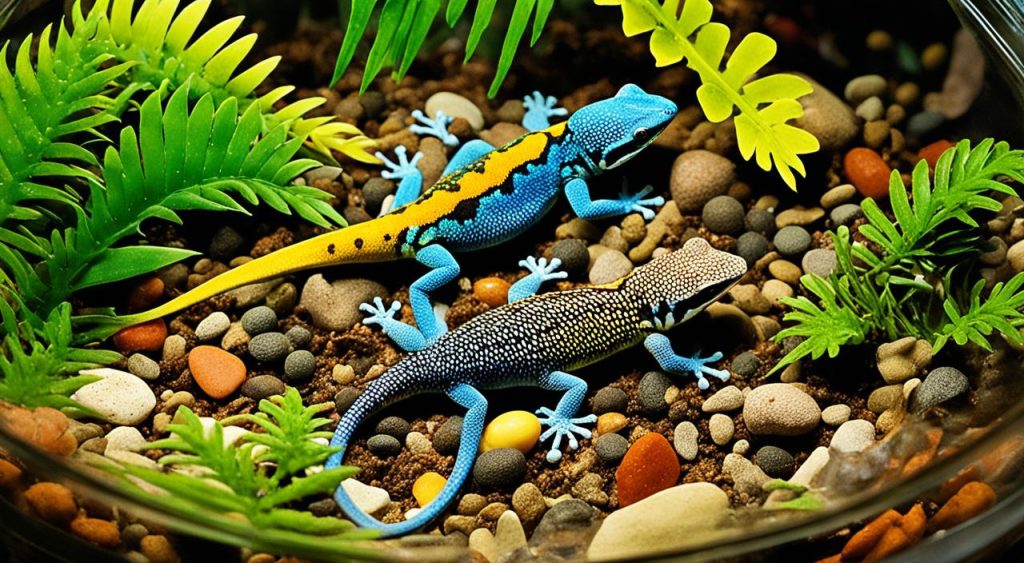
Communication Through Chirps and Clicks
Mourning geckos use chirps, clicks, and whistles to talk to each other. They have a strong “voice” and make a loud, single-syllable chirping noise. This noise sounds like “chik, chik, chik” and helps them socialize, warn each other, or just say hello.
At night, geckos are very vocal. They make sounds like clicks, chit-chat, trills, and barks. Males bark to keep other geckos away from their territory. Some sounds they make are too high for humans to hear, like chirps, clicks, and barks. In Hawaii, they click when they’re hungry or talking to other geckos.
Geckos use sounds to send messages about their feelings and surroundings. They make noise to warn others, show aggression, find a mate, or signal danger. In Hawaii, their sounds can be so loud, humans can’t hear them.
| Vocalization Behavior | Purpose |
|---|---|
| Chirping | Coordinating activities, signaling presence |
| Clicking | Communicating with other gecko species, signaling hunger |
| Barking | Warning off other geckos, establishing territory |
| Trilling | Attracting mates, expressing excitement |
Mourning geckos chirp 5-10 times at night to talk to each other. They also use tail waving, vocalizing, and other behaviors to show who’s boss in their group. But, they can also eat each other, which helps control their numbers and resources.
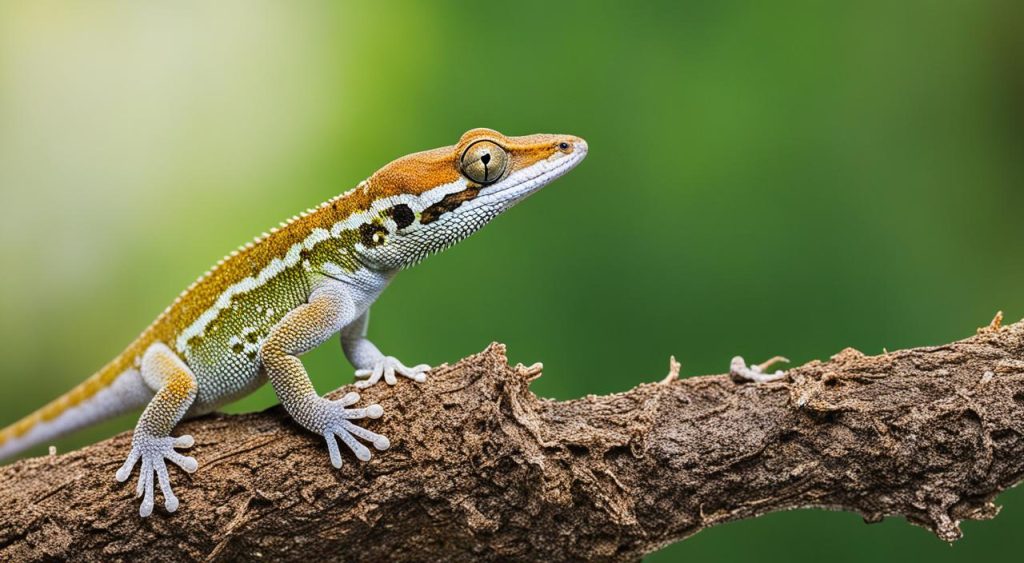
“Geckos utilize a variety of sounds, such as barks, chirps, and clicks, to convey messages based on their environment and emotions.”
Camouflage Experts: Color-Changing Ability
Mourning geckos are experts at hiding, changing their skin color to match their surroundings. They don’t change color as much as chameleons, but they can shift to shades of brown, tan, and grey. This helps them hide on tree bark, leaves, and other natural spots.
Blending In with Surroundings for Survival
This color-changing ability is key for mourning geckos. It helps them avoid predators and sneak up on prey by blending in with their environment. By changing color, they can disappear into the background, making it hard to spot them.
“Mourning geckos are true masters of camouflage, able to subtly shift their skin tones to seamlessly blend in with their surroundings. This remarkable ability is a crucial survival strategy for these tiny lizards.”
The mourning gecko’s camouflage abilities show how nature shapes creatures to survive. By hiding, they can stay safe, save energy, and go about their day without being noticed.
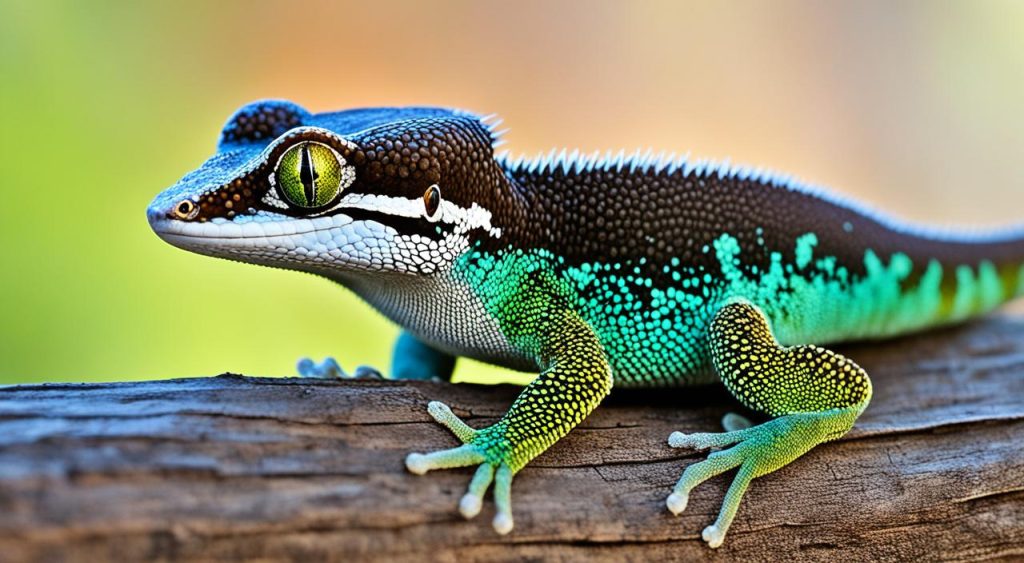
Sticky Feet: Geckos’ Climbing Superpowers
Mourning geckos can climb up vertical surfaces easily thanks to tiny hairs on their feet. These hairs work like tiny grippers. They let the geckos stick to smooth surfaces and climb up walls and ceilings with ease.
This skill is key for geckos to live in trees and avoid predators. Their sticky feet help them escape quickly. So, owners need to make sure their homes are secure to keep the geckos from escaping.
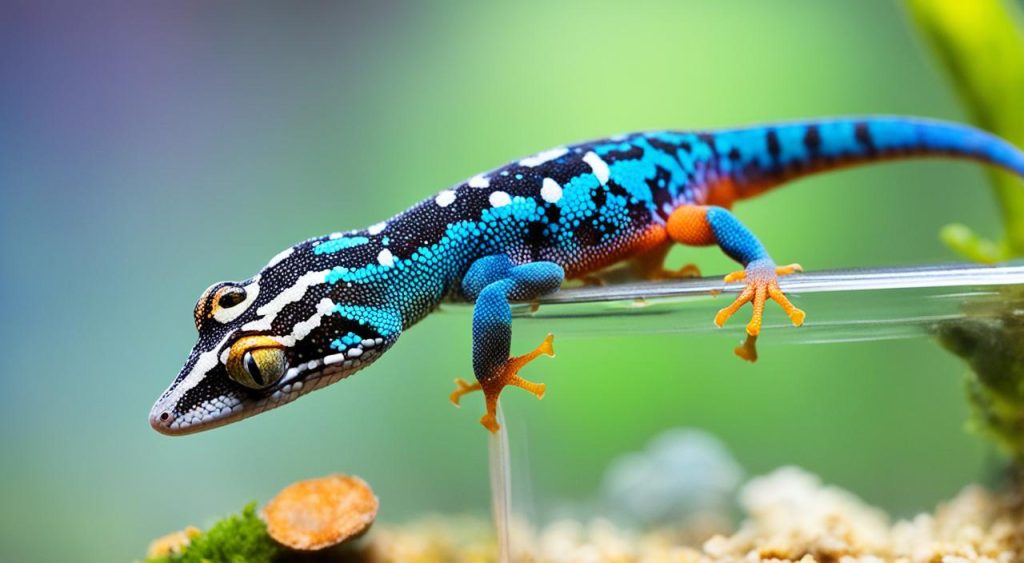
The toe pads of geckos are amazing. They have millions of tiny hairs that split into smaller branches at the tips. This design creates a huge surface area that sticks to smooth surfaces, letting the gecko climb up vertical obstacles easily.
“Geckos can scale smooth surfaces, including glass, due to the unique structure of their toe pads. The setae on their toes are so small and numerous that they can form intermolecular interactions with the surface, creating a powerful adhesive force.”
Geckos’ ability to climb is not just a survival trick but also a wonder for humans. Their agility and skill on vertical surfaces amaze and inspire us. They make great pets because of their unique abilities.
Mourning Gecko: A Low-Maintenance Pet Reptile
Mourning geckos are perfect for those new to reptile care. They are easy to look after and do well in captivity. These small lizards are only 3.5-4 inches long. So, they need a small space, making them a budget-friendly pet.
Affordable Housing and Dietary Needs
A good home for up to 3 mourning geckos is a 12″L x 18″W x 18″H enclosure. They like a humidity of 60-90% and need 12 hours of light and heat each day. The warm spot should be 80-85°F, with a cooler area of 70-75°F, and a cooler night of 65-72°F.
Don’t let the temperature go above 82°F to keep them safe from heat stroke.
These geckos eat both fruits and insects. Their food is easy to get, making them a cheap pet to look after.
Social Butterflies: Enjoying Group Living
- Mourning geckos are all female and can make copies of themselves without males.
- They can live together in small groups if there’s enough room and places to hide.
- It’s fun to watch these social animals play and check out their home.
Mourning geckos are easy on the wallet and do well in groups. They make great pets that can bring happiness and interest to their owners.
Escape Artists: Secure Enclosure Essentials
Mourning geckos may be small, but they are escape artists. They can climb and squeeze through tiny openings. Keeping them safe in their enclosure is important for their well-being and your peace of mind.
To stop your mourning gecko from escaping, design their enclosure carefully. Use a mesh lid with no gaps for them to slip through. Block even the smallest holes, as they can bend to fit through narrow spaces.
- Check the enclosure for any gaps or cracks where they could escape.
- Give your gecko hiding spots and clutter to make it feel secure.
- Use a lock on the enclosure’s door or lid to prevent accidental openings.
By taking these steps, you can make a safe mourning gecko enclosure. This will keep your pet safe and stop them from escaping. Choose a secure housing to let your mourning gecko live without worrying about them avoiding escapes.
“With the right precautions, you can enjoy the company of these fascinating tiny lizards without worrying about them vanishing into thin air.”
Recognizing Their Caretakers
Mourning geckos don’t usually get handled as pets, but they can learn to recognize their owners. With careful watching and a calm space, they might start to link their owners with good times, like when they get food. This shows how smart and flexible mourning geckos are, even if they’re not as social as some other reptiles.
These geckos are great at interacting with humans and can form a bond with their owners. By always being gentle and rewarding them, they might get more used to their owners. They might even seem more calm or alert when their owner comes near.
The bond between a gecko and its owner is quite interesting when it comes to mourning geckos. They might not be the most social reptiles, but they can still recognize their owners. This makes caring for them rewarding for reptile lovers. By knowing and meeting the special needs of mourning geckos, owners can build a strong connection with these unique creatures.
“Mourning geckos may not be the most interactive pets, but their ability to recognize their caretakers is a testament to their intelligence and adaptability.”
Big Personality in a Tiny Package
Mourning geckos may be small, but they have big personalities. They are perfect for reptile lovers who want something unique. These tiny lizards can change color and talk to each other, showing off their special traits.
They are easy to care for and make great pets. They don’t need much food or a big space. Plus, they can recognize their owners, making them even more charming.
The mourning gecko stands out among reptile pets. Their ability to change color and communicate is fascinating. They offer a special bond that reptile fans will love.
FAQ
What is the mourning gecko?
The mourning gecko (Lepidodactylus lugubris) is a tiny, nocturnal lizard. It’s a favorite among reptile lovers. These geckos can reproduce on their own, a rare ability called parthenogenesis.
How do mourning geckos reproduce?
These geckos are all female and can reproduce without males. They use parthenogenesis to make copies of themselves. This means they lay eggs that are identical to them.
How do mourning geckos communicate?
They talk to each other with chirps, clicks, and whistles. You might hear a loud “chik, chik, chik” sound. This helps them stay in touch with their friends.
Can mourning geckos change color?
Yes, they can change their skin color to blend in. They don’t change color as much as chameleons, but they can turn brown, tan, or grey to hide.
How do mourning geckos climb?
They climb really well thanks to tiny hairs on their feet. These hairs help them stick to walls and ceilings. It lets them move up and over obstacles easily.
Are mourning geckos easy to care for as pets?
Yes, they’re great for beginners. They’re small, don’t need a big space, and eat simple foods. This makes them a budget-friendly pet.
Do mourning geckos require a secure enclosure?
Yes, they can escape easily because they’re small and climb well. Make sure their home has a tight lid and no gaps. Adding places to hide can also help keep them in.
Do mourning geckos interact with their owners?
They might get used to their owners over time. With patience and a calm space, they can learn to look forward to seeing their owners. They show they’re smart and can adapt.
Why are mourning geckos a good pet choice?
They may be small, but they have big personalities. Their ability to change color, communicate, and climb makes them interesting pets. They’re sure to entertain and delight their owners.
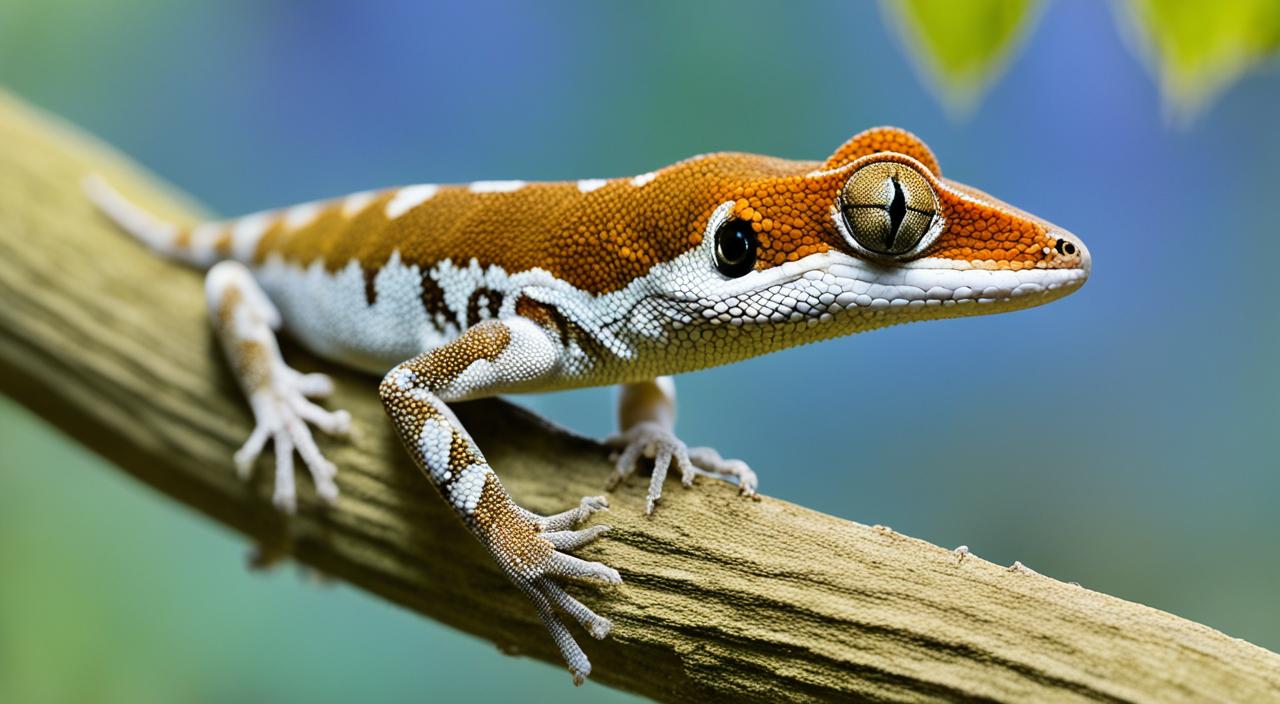


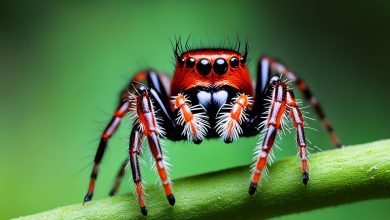

One Comment